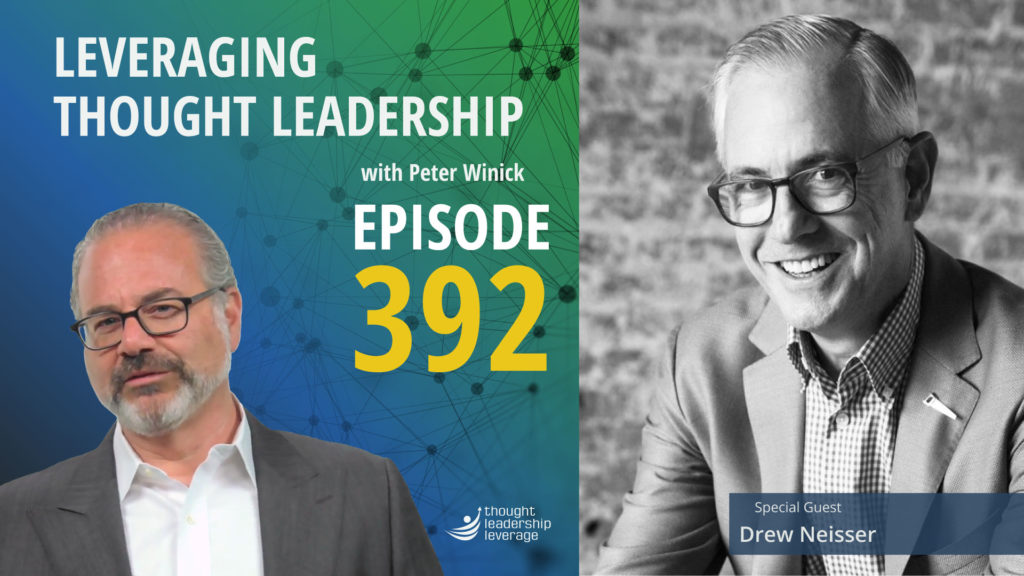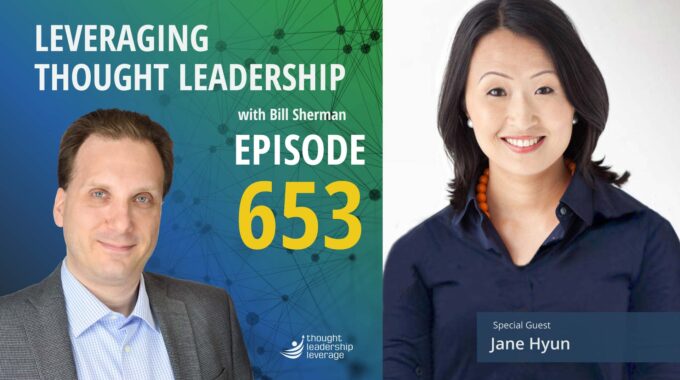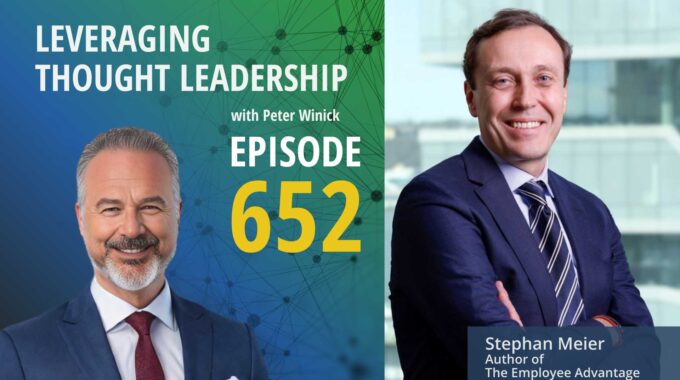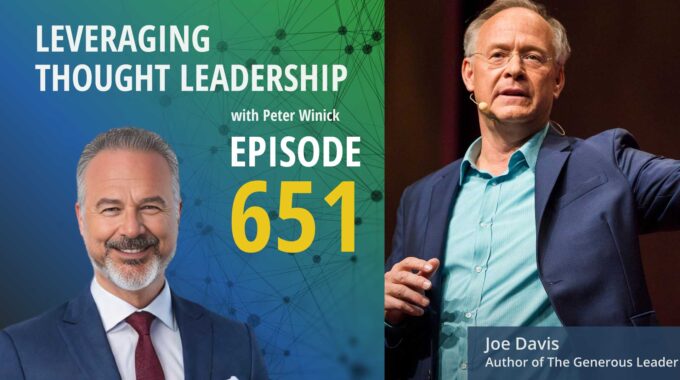The Hidden Barrier to Engagement and How to Break Through This episode unpacks how cultural…
Convergence of Thought Leadership and CMOs | Drew Neisser

How to properly use thought leadership for marketing.
An interview with Drew Neisser about how CMOs address and use thought leadership.
Chief Marketing Officers (CMO) often think in terms of campaigns, responses, and calls to action. Everything is about selling a product or service. So, when it comes to using thought leadership for marketing, how do you thread the needle? How do you show CMOs that thought leadership can develop a brand, bring in new clients, and not look like just another advertisement?
To tackle this tough question, we’ve invited Drew Neisser, the Founder of Renegade, a B2B marketing agency that helps their clients do the heavy lifting of brand strategy, market research, content, and social media. Drew is also the author of Renegade Marketing: 12 Steps to Building Unbeatable B2B Brands, helping readers remove the complications of B2B marketing.
For thought leadership to be successful, you need to be clear about what you are trying to accomplish. Drew discusses the way CMOs should be focusing their efforts, and ways to express how thought leadership differs from traditional marketing.
Once you have a clear purpose, you need a clear vision. Drew explains that thought leadership needs to be developed from the viewpoint of the customers, creating content that encourages them to think more deeply about problems in order to find solutions. Drew’s CATS (Courageous, Artful, Thoughtful, and Scientific) method is one such framework. It can be used as a guiding light to ensure your content hits all the right targets.
We conclude the conversation by examining Drew’s goals Drew in writing his book. He set out to make B2B marketing easier by creating a 12-step program that he used in the field to gain real-life feedback and viscerally improve the book. Drew shares how the pandemic affected the release schedule of the book, and how he stripped it back to a massive blog post — which then exploded in popularity, proving that he was on the right track.
B2B marketing has never been more complicated. If you are struggling to find your share of the market, this episode might just have the advice you need to find your audience.
Three Key Takeaways:
- Thought Leadership content should be created with the focus of helping clients solve problems by looking at challenges from a different perspective.
- Low or mid-level marketers should consider creating thought leadership content early in their career, as a means of building a reputation for the long run.
- Make sure you’ve considered the three C’s when creating thought leadership: Content, Connection, and Community!
If you need a strategy to bring your thought leadership to market, Thought Leadership Leverage can assist you! Contact us for more information. In addition, we can help you implement marketing, research, and sales. Let us help you so you can devote yourself to what you do best.
Transcript
Peter Winick And welcome, welcome, welcome. This is Peter Winick. I’m the founder and CEO of Thought Leadership Leverage, and you’re joining us on the podcast today, which is Leveraging Thought Leadership. Today, my guest is Drew Neisser. Drew is the founder of Renegade, the award winning strategic boutique for B2B innovators and CMO Huddles. And he is the author of a couple of books, the most recent being Renegade Marketing. He is, let’s see, ranked among top CMO influencers. He’s been on ABC News, CNBC, all those usual suspects. But instead of talking about him, I prefer to talk with him. So welcome aboard, Drew. Thank you for joining us today.
Drew Neisser Hey, Peter. Thank you. And thank you for having me. But thank you for doing your podcast because as a podcaster, I know how much work these there are. So I really appreciate it.
Peter Winick Oh, thank you. So what sort of dove in here? So your domain expertise, your thought leadership is about CMO’s, obviously marketing, etc., etc.. Selfishly, I’ll ask where do you see CMO’s embracing thought leadership, being confused by and maybe not having knowing sort of how to process it?
Drew Neisser Well, look, I’m going to try to break it down. I mean, you sure? You’re right. That is my expertise. I’ve interviewed probably over 500 CMO’s now, plus with CMO huddles. I’m talking to 50 plus every single month. But thought leadership is fits in this giant domain of their personal brand, the company brand, the executive brand and this horrible beast called a content calendar. And in between all of that, I would say under a even greater category in 2021, the last quarter, everybody was seeing digital fatigue. And what that meant was all content consumption, whether it was webinars or blog post or video, they were seeing a decline in the effectiveness of it. So there’s a lot of red flags right now and a lot of sort of shifting in thought in terms of how are we going to get more out of our marketing and content is a huge subset.
Peter Winick Yes. So let me push back on that a little bit. So I agree there’s been a flood of stuff. People are exhausted. They’re doing that. Part of it is because there’s a lot of garbage out there, the kind of crap out there. I mean, you know, people don’t consume. You know, it’s still full. All the people all the time. I want to sort of draw the line between church and state, if you will, between content marketing and thought leadership, because I think there’s a lot of confusion, whatever. And it’s not that one is better than another or smarter than another or whatever. But how do you how do you see that playing out? Well.
Drew Neisser I think probably more importantly, you see a distinction that maybe CMO’s don’t.
Peter Winick Yeah. Okay. No, that’s true.
Drew Neisser And I think when they think of thought leadership, they think of that either as their reason for doing content or as part of what they do as part of their content program. It’s okay. But right.
Peter Winick But most marketers and by the way, I’m a marketer as well, I think in terms of campaigns and response and call to action as they clearly should. Right. So if I you know, here’s a pen. If I was marketing this pen, there’s lots of content I could think of to come up with to best effectively market this part. It could be funny, it might be video, it might be articles, it would be academic papers. But there’s a whole slew of thing all in service of getting someone to buy the pen or to differentiate the pen. Or this pen is better than another pen, right? When it comes to thought leadership, I think we’re seeing most struggle and they’re not really sure where to embrace this beast is a where’s it live and what does it do? Right. So at some level, yes, it’s there to build the brand. At some level, yes. It’s there to acquire net new clients. But there’s a little bit of, you know, holier than thou there. We don’t talk about product and thought leadership. We don’t talk about use case or benefits or features as we would in content marketing. So I think there is a distinction and it’s like anything else is yet another tool in the toolbox. No one to use which one weighs.
Drew Neisser Yeah. I’m sort of one of the things that I’ve tried to do in the book is radically simplify all of this. And yeah, because B2B marketing had gotten ridiculously complicated, we had done all sorts of research and showed that 90% of the realized that B2B marketing had off the charts and it hadn’t correlated to increased effectiveness. So and that was over a two year period of research that we did. And the problem is the peanut butter effect, right? They’re just doing too many things across too many categories with too much data. And the result is there is no actually one single core idea that holds pieces together. So if we set that up as a problem solving issue fits into all of the solution as long as it supports the brand strategy.
Peter Winick Yeah, exactly.
Drew Neisser And that’s a key thing here. So I think it’s thought leadership in my book, at least where I see the biggest problems with thought leadership, are that it is focused on if we’re gonna get new customers, we got to get it as a, as a acquisition tool. And as a result of that, it often doesn’t serve any master, but if they think about it from a customer standpoint. Secondly, by the way, I think employees are probably the first. If your employees don’t read your content, that’s a problem, too, right. But let’s just talk about if you do thought leadership for your current customers, you never lose.
Peter Winick No, still do. So stay there a minute because I think you’re thousand percent right is it’s got to be tight. So who are the avatars you’re trying to connect with and the tone and the language and what you’re saying and how you’re saying it is very different if you’re reaching out to marketers or the C-suite or technical people, whatever. And then the next thing I would say is not just the avatars. What are their pain points? So if you you know, it’s sort of like paying Mad Libs or something. If you can’t match those two things up, who cares? And you have to give me insight. You can’t be regurgitating what I already know. You’re giving me insight, you’re giving me knowledge. And give me a different way to think about the problem, to build the trust that I have to eventually reach out to you and say, hey, you know, Hey, Drew, you’re out. Read your stuff, read your book. Can you help me?
Drew Neisser Yeah. I mean, it sounds simple when you say it. I mean, we break it down. But the reality is, we both know that most content isn’t worth reading. Your content isn’t worth watching. And the reason I think boils back to and I sort of in the book, I create this framework called the CATS (Courageous, Artful, Thoughtful, and Scientific). And I believe if you use that as a guiding light for your content, your win in most content isn’t courageous because it doesn’t differentiate. It doesn’t help distinguish the branded.
Peter Winick So I put that in the leadership side of thought. Leadership is you have to have the courage to take the conversation to a new place, a different place. Exactly that someone hasn’t put otherwise. It’s what’s.
Drew Neisser The point? You’re just recycling, right?
Peter Winick What’s not right.
Drew Neisser So courage and this is this notion of daring to be distinct, applies so effectively to content. Right? And one of the ways that we can distinguish ourselves is we’re individuals. We have our own point of view. And this is where this is where it gets really tricky. And, you know, you see great content from CEOs often where they’re really expressing there are a few B2B CEOs that are really good at this or executives are really good writers and you follow them and they built a cult of personality. Right? I think there’s something to that on its own, but I think brands can do it too, and CMO’s can do it too. And I’m seeing a lot more CMO’s get out there in expressing it in this game. One of the things that came out of the pandemic that is good is the, you know, suddenly CMO’s recognize, oh, empathy, that’s an important word. It’s an important idea.
Peter Winick But I want to go before that. By the time I’ve had CMO now, other than probably looking for my next job due to the average tenure of a CMO, which is different problem, I’m at the level that I want to be, right? What I would argue is five, ten, maybe even a dozen years before that, what are you doing as a junior, mid-level up and coming marketer to establish a sense of thought leadership? Because all else being equal, if I have a choice hiring Drew or Peter and Drew’s written a book and Drew’s written articles do different speeches, I kind of get that for free has the right. So that comes along with it and I think that’s a big deal is building this before you need it and it’s better than personal branding.
Drew Neisser Yeah, I completely agree. I have to say. I mean, when I started writing articles for initially it was Fast Company and I said in 2007, I said, I’m going to write an article every single week. And then once I started writing those articles every week, I realized, Oh, I’m going to need something to write about. So I started to interview chief marketing officers, and then this thing snowballed. I mean, after the first hundred interviews, I had my first book and so. So I think you’re right in it. And it but it takes time and it takes consistency and it takes a point of view and a lot of diligence. Diligence. Now, here’s an interesting part of this. After the 200th interview, I started the podcast because why the heck not right is all right. Right. 400th interview, the next book. But there was a business in there that I didn’t realize. And that’s where CMO Huddles came out.
Peter Winick Which is community, which is a connection and community, right? So to me, there’s the three C’s of leadership or the content, which used to be the only C, but then there’s the connection and then the community. So I mean, you’re talking about exactly that. You’ve now put together these CMO huddles, which are communities of marketers, of chief marketing officer. So they’re coming together to talk about what to do. So there’s a content piece, there’s a connection piece, there’s a community piece.
Drew Neisser Well, and also just to sort of put a nice ribbon on that or a bow on it, is that having done all these interviews, I’m suddenly uniquely positioned to continue that, to have the conversations with these folks. I didn’t know that when I started. And so if you’re a mid-level marketer now and thinking about your own personal brand and, you know, there is nothing like making a commitment to start writing, because when you make a commitment to write, you make a commitment to having a point of view right it because if you don’t, no one’s going to read it. But as you do it, you get better and better and better, you know, or you get easier for you. And ultimately good things happen. I mean, and this is the thing most people Dorie Clark talks about that a lot of people record like nine podcasts and give up. Most people start writing totally true and give up. And I think that’s part of it. But I will say for brands, just consistency is important, but it’s not enough.
Peter Winick If you’re enjoying this episode of Leveraging Thought Leadership, please make sure to subscribe. If you’d like to help spread the word about our podcast, please leave us a review and share it with your friends were available on Apple Podcasts and on all major listening apps as well as at Thought Leadership Leverage dot com forward slash podcasts.
Peter Winick But when you’re talking about consistency, I think there’s also consistency in cadence. So I know, you know, in the 1800s when I started blogging and I’m a mediocre writer at best, a good I went to a couple of good friends that were blogging already for a while and I said, okay, give me the hacks, give me the give me, give me the shortcut. And one of them, a buddy of mine that knows me. Well, listen, you’re like everybody else. You’re an entrepreneur, you’re impatient. You want to see instant results. Don’t commit to writing one blog, commit to writing one. And I was like, Wow, like 100. And he’s like, Yeah, because you’re going to get impatient. You look at the data and number five didn’t do anything. By the time you get to 15 or 20, you’ve made your case that this is pointless and you’ll stop doing it. He was 1,000% right when I want my podcast and we’re on coming up on 400 episodes in four years now. I didn’t commit to 100. I committed to 50. Right. And it was true. It was right about that like 30, 35, 40 mark where I started to see a little bit of the flywheel people reaching out to us. Now it pays dividends, there’s a flywheel, it’s working. And I have to put in less effort. And it not that it runs itself, but we have a library of back catalog. We’ve done a lot of work and by the way, we’ve invested a ton of time, energy, effort, money into doing it, making sure that is of a certain quality.
Drew Neisser And yeah, in as you’re thinking, this is a sidebar, but one of the ways that we’re encouraging our clients in the same way as I talk to in huddles is everything in 2022 is going to be about less but better. And so one of the things about doing less but better is that you invest a lot in whatever one particular piece, like we’re big fans of research studies, we do this, it’s very research studies. They take a fair amount of time to do. But when you’re done, you get a proprietary piece of research that you can sell against, that you can inform your customers about, that you can repurpose this. Yeah, you can cut it up into.
Peter Winick All day.
Drew Neisser Webinars. So if you are investing in one good thing, you end up with 30 different pieces out of it or more, and these things have long value, then you just show up.
Peter Winick So that’s a great segway to where I was going next, which is, you know, you’ve just recently come out with your book Renegade Market, right? And there’s lots of ways to write a book and there’s lots of reasons to write a book. And what I love is because you’re a marketer, you’re focused. So I don’t believe in on want to put words in your mouth that you wrote this book thinking this will be the next great, but it’s only money. So let’s start because I think a lot of people are delusional when they write a book. Tell me, let’s work this backwards. What were the goals and objectives that you had when you made the commitment to write the book? Well, what would a what success looks like?
Drew Neisser Right. Well, it started with this it started about four years ago when I saw well, first of all, it started ten years ago when I wrote my first book and realized, okay, I’m going to write three books. The first one will be just the book that was easiest to write. The second one will be a something on B to B marketing. I didn’t know why. And the third one will be about Ben Franklin and stay tuned on that later on the second one. So about four years ago, we saw this trend that B2B marketing was. Getting ridiculously complicated. So we said, can we solve this problem? So we created a process is a 12 step process. We’re thinking, let’s see if it works. I actually went out and started talking to CMO’s about this and got some more things. I kept doing interviews.
Peter Winick Which was right there because it regardless of the domain in your case is CMO is we advocate doing the same thing. So oftentimes we’re thought leaders are guilty, not marketers or they create isolation. I’m going to spend a year researching, writing this book, whatever, whatever. Go to the market quickly and talk to them. They will tell you what’s on their minds. They will tell you what’s bothering them. But so many people are afraid to do that. And by the way, you frame it in a case of not that I have a definitive thing yet, but I’m doing a little homework on this. Do a little research on this. I’d like to grab an hour of your time, Drew, and talk about blah, blah, blah. Right. And I think not enough people do that.
Drew Neisser And so we created this little 12 step guide, literally created that went on a road show I presented about, I’m going to say seven times to small groups of CMO’s. Okay, I get to see if it would resonate. Then I wrote up the book. Okay, this was and I was done February 2020.
Peter Winick Okay.
Drew Neisser Comes the pandemic. I put the book on hold and said, I don’t know. I want to be sure that this book is still relevant. So I waited almost an entire year, actually longer, kept doing interviews, kept figuring, and then sort of the process didn’t change. We flipped one step, but the process didn’t change. And suddenly it got better because I now had new cases that supported the story and we had pandemic relevance. So I knew we could go past love it. So but rather than just wait for another year and a half, we took the book version and the first one I wrote sure. Stripped 30,000 words out of it, put out 15,000 word blog post, 50,000 word blog post. The mother of all blog posts free unguarded on renegade dot com with some very good SEO in it. If you type in B2B brand strategy, generally renegade comes up first because of that mother of all blog posts. So it isn’t sort of the original thing was can we solve this problem? We went out and learned about it. We applied it to our clients and then wrote the book and then waited. But we didn’t, you know. So part of the validation of the book also was while I was I was rewriting it was that this blog post was like, unbelievable.
Peter Winick So that gave you market validation that there’s a thing here. I’ve kept it exactly scratched in it. So go back, though and say, great. You’ve now validated what I’ve done in this research would make a good book. Right? But go back to the the goal of the book. Right. Because this isn’t going to be, you know, good to great or in search of excellence. No, no disrespect there, but what did you want the book to achieve? Is it about brand? Is it about net new client acquisition? Is it about showing people your frameworks and models that they know what they get when they work with you? What were the what were the.
Drew Neisser Yeah, I think that’s really it. What I have found. And so the minute the book was done, I could send this to every prospect that we had. And it said, Look, read this. This is how we think this is going to you. No matter what happens, you’re going to get value out of this. And this is our approach. And if you’re aligned with this approach, we can work together great. And so and we do two things in addition to helping brands, I help CMO is on an individual level. So now if they read the book, there’s a shorthand here.
Peter Winick Right. So they so stay there a minute. So I’m going to extrapolate from the book high quality thought leadership. Right. So I know in my world, speaking both for myself and clients, when someone has invested the time in your thought leadership, whether that’s reading your book, your articles, your videos, your podcasts, and then they reach out to you. First of all, you’re not aware that they’re even in your sales cycle or whatever, and they come to you. And the sales cycle has just been really short. Why they’re quoting you back or saying, listen, a drug just finished your book, so you already know. They know your models, you know your framework, whatever, where to take the discussions you’re going to ask and things like what resonated with the most, the most with you? What did you find or whatever? So I love that thought. Leadership becomes the accelerant, the sales. And by the way, you could also say, I don’t agree with anything this guy says. I’m not going to call column and that’s okay.
Drew Neisser Exactly. No, I mean, this is all about narrowcasting. I mean, we just there isn’t time. We you know, I hate the expression boil the ocean. But it’s true with marketing. And if we want to avoid a bit of that, we might as well. And again, we’re going back to dare to be distinct. I’m giving you a point of view. I’m giving you a strong thing. What’s the renegade thing? Employees. Customers, then prospects in that order. If you don’t believe that.
Peter Winick I’m not your guy. Right. Right.
Drew Neisser We’re not in it. But if you believe that without your employees being able to. To sort of buy into the brand, you can’t be successful. We should. And I would.
Peter Winick I would imagine you have people coming to you and say, you know, through I’ve been to see them over 20 years and I never thought about this employee first approach. Read your stuff. Look at your stuff. I want to have a conversation because now I’m considering changing my thoughts on that or yeah, right. So it’s not that they disagree, but they just may never have, as most haven’t thought of it that way. That’s your special sauce, right? Because everybody else, I mean.
Drew Neisser They haven’t thought about it. Most of them haven’t. And so we have a in the book, there’s actually an employee survey that they well, you know, and that’s a step for us in our branding process. But look, knock yourself out. Go. And part of it now is renegade has sort of become museum. O’Hara’s has been really successful. I’m so thrilled. I’m so grateful for that. And so I’m not we’re very selective now with renegade clients. Everything we’re doing now is mainly about helping CMO’s and CMO huddles, and this book is supporting that.
Peter Winick In one big ecosystem. It all plays actually well. Yeah. So this has been great. I appreciate your time. I appreciate you sharing everything that you have and your perspective. And you and I could talk for hours, but this is fantastic. And thank you for sharing.
Drew Neisser Thank you, Peter.
Peter Winick To learn more about Thought Leadership Leverage, please visit our website at ThoughtLeadershipLeverage.com to reach me directly. Feel free to email me at Peter at ThoughtLeadershipLeverage.com and please subscribe to Leveraging Thought Leadership on iTunes or your favorite podcast app to get your weekly episode automatically.






